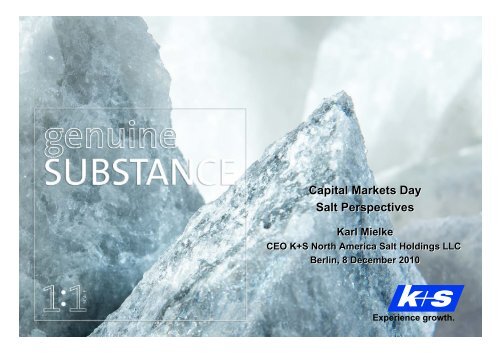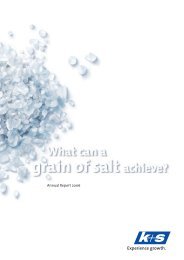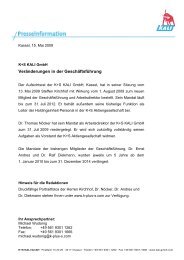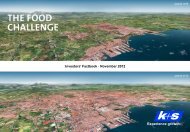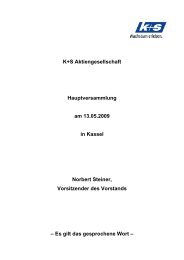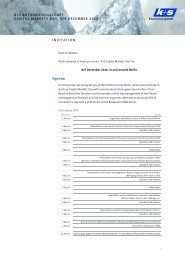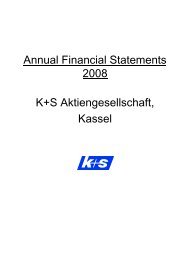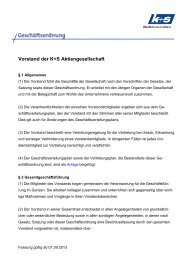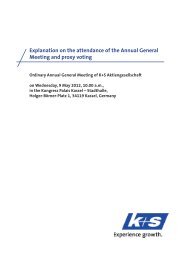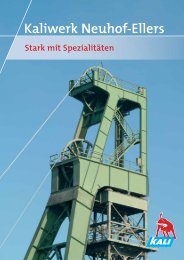Presentation of Karl Mielke, CEO K+S North America Salt Holdings ...
Presentation of Karl Mielke, CEO K+S North America Salt Holdings ...
Presentation of Karl Mielke, CEO K+S North America Salt Holdings ...
Create successful ePaper yourself
Turn your PDF publications into a flip-book with our unique Google optimized e-Paper software.
Capital Markets Day<br />
<strong>Salt</strong> Perspectives<br />
<strong>Karl</strong> <strong>Mielke</strong><br />
<strong>CEO</strong> <strong>K+S</strong> <strong>North</strong> <strong>America</strong> <strong>Salt</strong> <strong>Holdings</strong> LLC<br />
Berlin, 8 December 2010<br />
Experience growth.
<strong>Salt</strong><br />
Content<br />
A. <strong>Salt</strong> Market Environment<br />
B. The <strong>K+S</strong> <strong>Salt</strong> Business<br />
C. <strong>K+S</strong>’ Position in Competitive Environment<br />
D. Growth Perspectives & Strategy<br />
December 2010 <strong>K+S</strong> Group 1
No Life without <strong>Salt</strong>!<br />
<strong>Salt</strong> is…<br />
… a fundamental component <strong>of</strong> our life<br />
These are the following main production methods <strong>of</strong> salt:<br />
Rock <strong>Salt</strong><br />
Sea-/Solar <strong>Salt</strong><br />
Evaporated <strong>Salt</strong><br />
Brine<br />
Conventional<br />
mining<br />
Crystallisation<br />
from sea water<br />
Recrystallisation<br />
<strong>of</strong> purified brine<br />
Controlled<br />
borehole-brining<br />
December 2010 <strong>K+S</strong> Group 2
<strong>Salt</strong><br />
Details <strong>of</strong> the Market for <strong>Salt</strong> for Chemical Use<br />
• Largest salt product market with global<br />
chemical industry consuming approx. 150 Mt<br />
per year as feedstock<br />
• Main applications:<br />
• chlor-alkali industry (→ PVC)<br />
• synthetic soda ash production (→ glass)<br />
Electrolysis<br />
facility<br />
• Key demand drivers:<br />
• GDP growth<br />
• urbanization<br />
• Success factors:<br />
• efficient sourcing and logistics network<br />
• reliant delivery capacity<br />
December 2010 <strong>K+S</strong> Group 3
<strong>Salt</strong><br />
Details <strong>of</strong> the De-icing <strong>Salt</strong> Market<br />
• Clients are mainly municipalities and other public<br />
authorities<br />
• Contract award is mainly based on public bidding<br />
process<br />
• Main application:<br />
• salt used as de-icing agent for highway safety<br />
• Key demand drivers:<br />
• winter weather conditions<br />
• infrastructure development<br />
• Success factors:<br />
• efficient sourcing and logistics network<br />
• delivery capacity<br />
December 2010 <strong>K+S</strong> Group 4
<strong>Salt</strong><br />
Details <strong>of</strong> De-icing <strong>Salt</strong> Bidding Processes<br />
defined by<br />
Details specified in typical<br />
bid document<br />
volume<br />
destination<br />
delivery<br />
product and service<br />
specifications<br />
guaranteed minimum<br />
purchase requirement<br />
maximum delivery<br />
requirement<br />
price<br />
vendor purchaser<br />
• Government de-icing contracts are awarded in<br />
Europe, the US and Canada in the form <strong>of</strong> public<br />
bids<br />
• Government purchaser issues bid documents in<br />
late spring/early summer<br />
• Vendors hand in sealed bids, which will be<br />
opened at date and time specified in the bid<br />
documents<br />
• Lowest priced bid that satisfies all requirements<br />
will be awarded<br />
• In the US, Canada and most parts <strong>of</strong> Europe, all<br />
vendor’s bids will become public<br />
• In the US most bids are valid for one year/season<br />
• In Canada and some parts <strong>of</strong> Europe contracts<br />
might be awarded for a duration <strong>of</strong> up to 4 years<br />
December 2010 <strong>K+S</strong> Group 5
<strong>Salt</strong><br />
Details <strong>of</strong> the Food Grade <strong>Salt</strong> Market<br />
• Main applications:<br />
• table salt (Consumer)<br />
• food processing<br />
• Key demand drivers:<br />
• population growth<br />
• eating habit<br />
• Success factors:<br />
• high quality standards<br />
• marketing/branding<br />
(especially in <strong>North</strong> and South <strong>America</strong>)<br />
• supply chain efficiency to fulfil customer<br />
requirements<br />
• Current situation:<br />
Within the US and some European countries<br />
increasing political pressure to reduce the<br />
consumption <strong>of</strong> sodium<br />
December 2010 <strong>K+S</strong> Group 6
<strong>Salt</strong><br />
Industrial/Other Applications <strong>of</strong> <strong>Salt</strong><br />
The industrial salt market comprises different<br />
high-value applications:<br />
• Pharmaceutical<br />
• Highly regulated, high-margin segment<br />
• Main use in infusion and dialysis solutions, as<br />
well as cosmetics and drugs<br />
• Water s<strong>of</strong>tening<br />
• Used in municipal and private household<br />
water treatment<br />
• Oil and gas drilling<br />
• <strong>Salt</strong> used as drilling agent in oil and gas<br />
exploration<br />
• Animal feed<br />
• Animal feed salts serve as raw ingredient to<br />
industrially assembled feed mixes<br />
December 2010 <strong>K+S</strong> Group <strong>K+S</strong> Group 7
<strong>Salt</strong><br />
Main End Uses for <strong>Salt</strong><br />
• <strong>Salt</strong> has more than 14,000 different applications<br />
• <strong>Salt</strong> prices vary from approx. 40 US$/t (certain chemical salts) to approx. 1,000 US$/t<br />
(pharma salt)<br />
• Main applications <strong>of</strong> salt are: input for chemical processes, food grade and de-icing<br />
<strong>North</strong> <strong>America</strong><br />
(Consumption 2007: 69 million tonnes)<br />
Global<br />
(Consumption 2007: 259 million tonnes)<br />
Industrial/Others<br />
10.0%<br />
De-icing<br />
<strong>Salt</strong><br />
14.0%<br />
Asia<br />
(Consumption 2007: 94 million tonnes)<br />
Europe<br />
(Consumption 2007: 72 million tonnes)<br />
Food<br />
Grade<br />
<strong>Salt</strong><br />
17.5%<br />
Sources: Roskill 2007, <strong>K+S</strong><br />
<strong>Salt</strong> for<br />
Chemical<br />
Processes<br />
58.5%<br />
South <strong>America</strong><br />
(Consumption 2007: 14 million tonnes)<br />
December 2010 <strong>K+S</strong> Group 8
<strong>Salt</strong><br />
Main <strong>Salt</strong> Suppliers Worldwide<br />
Capacity in million tonnes (crystallised salt and salt in brine; excl. captive use)<br />
3.5<br />
13.1<br />
14.4<br />
14.0<br />
9.7<br />
18.7<br />
Compass<br />
Cargill<br />
7.5<br />
Artyomsol<br />
5.3<br />
4.1<br />
Südsalz<br />
Salins<br />
3.6<br />
Akzo<br />
China National <strong>Salt</strong><br />
7.0<br />
ESSA<br />
9.0<br />
7.0<br />
Dampier<br />
3.8<br />
Mitsui<br />
Sources: Roskill 2007, <strong>K+S</strong><br />
December 2010 <strong>K+S</strong> Group 9
<strong>Salt</strong><br />
Content<br />
A. <strong>Salt</strong> Market Environment<br />
B. The <strong>K+S</strong> <strong>Salt</strong> Business<br />
C. <strong>K+S</strong>’ Position in Competitive Environment<br />
C. Growth Perspectives & Strategy<br />
December 2010 <strong>K+S</strong> Group 10
<strong>Salt</strong><br />
Steps in Developing the <strong>K+S</strong> <strong>Salt</strong> Business<br />
5<br />
Acquired Morton <strong>Salt</strong>,<br />
the largest salt producer<br />
in <strong>North</strong> <strong>America</strong><br />
<strong>K+S</strong><br />
4<br />
Morton<br />
<strong>Salt</strong><br />
Acquired No.1 salt<br />
producer in South<br />
<strong>America</strong> through SPL<br />
acquisition<br />
- Market entry into U.S.<br />
and Latin <strong>America</strong><br />
SPL<br />
1<br />
2<br />
3<br />
Originally, salt<br />
business with high<br />
exposure to de-icing<br />
and industrial salt in<br />
Europe<br />
Added salt for chemical<br />
use through the acquisition<br />
<strong>of</strong> Frisia Zout (NL)<br />
Created No.1 salt<br />
producer in Europe<br />
through the acquisition<br />
<strong>of</strong> Solvay salt business<br />
December 2010 <strong>K+S</strong> Group 11
<strong>Salt</strong><br />
Strong presence in attractive de-icing regions<br />
Great Lakes<br />
• Continental climate with<br />
a distinctly stable winter<br />
• High population density<br />
• Very stable de-icing<br />
business with high<br />
quantities<br />
US – East Coast<br />
• Atlantic climate<br />
• Relatively volatile, to<br />
some extent severe<br />
winters<br />
• Very high population<br />
density<br />
• Stable de-icing<br />
business<br />
Eastern Canada<br />
• Atlantic climate<br />
• Relatively stable winters<br />
• Low population density<br />
• Stable de-icing business<br />
• Long-term contracts<br />
Western Europe<br />
• Atlantic climate<br />
• Rather mild winters with<br />
cyclic upward swings<br />
• Very high population<br />
density<br />
• Relatively cyclic deicing<br />
business<br />
Scandinavia<br />
• In comparison to<br />
Western Europe,<br />
stable winters<br />
• Relatively low<br />
population density<br />
• Relatively stable<br />
de-icing business<br />
December 2010 <strong>K+S</strong> Group 12
<strong>Salt</strong><br />
Balanced Product and Regional Portfolio<br />
Revenues by product group<br />
De-icing salt<br />
40%<br />
Other<br />
4%<br />
2005<br />
Food grade salt<br />
18%<br />
Industrial salt<br />
31%<br />
<strong>Salt</strong> for chemical use<br />
7%<br />
De-icing salt<br />
39%<br />
Other<br />
5%<br />
9M/2010<br />
Food grade salt<br />
20%<br />
Industrial salt<br />
31%<br />
<strong>Salt</strong> for chemical use<br />
5%<br />
Product mix:<br />
The very balanced<br />
product mix could be<br />
maintained over the<br />
years, even after<br />
acquiring SPL and<br />
Morton <strong>Salt</strong>.<br />
2005<br />
Overseas 1%<br />
Rest<br />
<strong>of</strong> Europe<br />
54%<br />
Revenues by region<br />
Germany<br />
45%<br />
Overseas 72%<br />
9M/2010<br />
Germany<br />
13%<br />
Rest<br />
<strong>of</strong> Europe<br />
15%<br />
Regional mix:<br />
The strong dependence<br />
on Europe could be<br />
diversified towards a<br />
more balanced regional<br />
mix with overseas sales<br />
in particular in the US,<br />
Canada, Chile and<br />
Brazil.<br />
December 2010 <strong>K+S</strong> Group 13
<strong>Salt</strong><br />
Mitigation <strong>of</strong> Volatility in De-icing Business<br />
Sales Volume De-icing <strong>Salt</strong> ISCO*:<br />
Sales Volume De-icing <strong>Salt</strong> Morton*:<br />
Sales Volume De-icing <strong>Salt</strong> esco*:<br />
5,000<br />
8,000<br />
4,000<br />
4,000<br />
6,000<br />
3,000<br />
1.000 t<br />
3,000<br />
2,000<br />
1.000 t<br />
4,000<br />
1.000 t<br />
2,000<br />
1,000<br />
2,000<br />
1,000<br />
-<br />
2006 2007 2008 2009 2010e<br />
-<br />
2006 2007 2008 2009 2010e<br />
0<br />
2006 2007 2008 2009 2010e<br />
10 year average sales volume (2000 – 2009) * before consolidation <strong>of</strong> intersegment sales volumes<br />
1.000 t<br />
14,000<br />
12,000<br />
10,000<br />
8,000<br />
6,000<br />
4,000<br />
2,000<br />
0<br />
2006 2007 2008 2009 2010e<br />
esco Morton SPL<br />
The worldwide de-icing salt market<br />
exhibits varying volatility<br />
Access to the largest de-icing world<br />
markets mitigates the overall degree<br />
<strong>of</strong> fluctuation in the de-icing salt<br />
business<br />
Unique, interregional production<br />
network (including access to salt<br />
production from potash facilities)<br />
allows benefiting from strong demand<br />
surges at short notice<br />
December 2010 <strong>K+S</strong> Group 14
<strong>Salt</strong><br />
Morton <strong>Salt</strong> Reduces Earnings Volatility<br />
Million €<br />
500<br />
400<br />
300<br />
EBITDA <strong>of</strong> <strong>Salt</strong> Business Segment<br />
(without Morton <strong>Salt</strong>) ≙ esco + SPL<br />
EBITDA <strong>of</strong> Morton <strong>Salt</strong><br />
EBITDA <strong>of</strong> <strong>Salt</strong> Business Segment<br />
Standard deviation<br />
<strong>Salt</strong> Business Segment (without<br />
Morton <strong>Salt</strong>): 42.4%<br />
<strong>Salt</strong> Business Segment<br />
(including Morton <strong>Salt</strong>): 20.5%<br />
%<br />
25<br />
20<br />
15<br />
200<br />
10<br />
100<br />
5<br />
EBITDA-Margin <strong>of</strong> <strong>Salt</strong> Business Segment<br />
(without Morton <strong>Salt</strong>) ≙ esco + SPL<br />
EBITDA-Margin <strong>of</strong> <strong>Salt</strong> Business Segment<br />
(including Morton <strong>Salt</strong>)<br />
0<br />
2000 2001 2002 2003 2004 2005<br />
0<br />
2006 2007 2008 2009LTM*<br />
2011e** 2008 2000 2009 2001 2002 2003 2004 2005 2006 2007 2008 2009 LTM*<br />
• With the acquisition <strong>of</strong> Morton <strong>Salt</strong>, standard deviation <strong>of</strong> EBITDA more than halved to approx. 20%<br />
• In addition, Morton <strong>Salt</strong> reduces volatility in EBITDA margins significantly<br />
• Furthermore, the level <strong>of</strong> EBITDA margin is also positively impacted by the acquisition <strong>of</strong> Morton <strong>Salt</strong><br />
* LTM=Last twelve months as <strong>of</strong> 30 September 2010; ** Middle <strong>of</strong> corridor between € 175 to 190 million, the current EBIT potential <strong>of</strong> the whole <strong>Salt</strong> business<br />
segment assuming normal de-icing salt sales at their multi-year average level<br />
December 2010 <strong>K+S</strong> Group 15
<strong>Salt</strong><br />
Historical and Recent Volume and Price Development<br />
Million tonnes Morton <strong>Salt</strong> (as <strong>of</strong><br />
€<br />
25<br />
1 October 2009)<br />
SPL (as <strong>of</strong><br />
70<br />
20<br />
1 July 2006)<br />
22<br />
21<br />
60<br />
55.5<br />
53.4*<br />
9<br />
49.1<br />
48.7<br />
50<br />
45.0 45.5<br />
9<br />
9<br />
15<br />
14.81<br />
40<br />
10<br />
5<br />
0<br />
6.07<br />
2.82<br />
3.25<br />
8.02<br />
3.90<br />
4.12<br />
8.77<br />
4.73<br />
4.04<br />
5.85 9.47<br />
5.00<br />
4.47<br />
5.85<br />
8.96<br />
2005 2006 2007 2008 2009 2010e<br />
13<br />
• Sales volumes increased over the past years mainly due to external growth, while the de-icing salt share<br />
remained rather stable<br />
• The price level for de-icing salt was tending upwards over the past years - a trend that might pause in 2010<br />
• Sales volume 2010e: 22 million tonnes (<strong>of</strong> which de-icing salt: 13 million tonnes)<br />
• Sales volume 2011e based on long-term average volumes: 21 million tonnes (<strong>of</strong> which de-icing salt: 12 million<br />
tonnes)<br />
* Average selling price in 9M/10<br />
December 2010 <strong>K+S</strong> Group 16<br />
12<br />
2011e<br />
30<br />
20<br />
10<br />
0<br />
De-icing salt sales volume<br />
Sales volume <strong>of</strong> industrial salt,<br />
salt for chemical use and food grade salt<br />
Yearly average price <strong>of</strong> de-icing salt
<strong>Salt</strong><br />
Cost Situation<br />
• Personnel<br />
• Annual work-time accounts in Germany make high degree <strong>of</strong> flexibility possible<br />
• Performance-related salary component, in Germany applicable to all employees<br />
• Personnel exchange with Potash and Magnesium Business Segment possible<br />
• Seasonal adjustment <strong>of</strong> workforce in <strong>America</strong> possible<br />
• Energy<br />
• One site in the Netherlands will switch to using steam from a substitute fuel heating plant<br />
in 2011<br />
• Continuous technical improvements and investments<br />
Outlook: energy cost increases will be mitigated in the medium-term perspective due<br />
to the above-mentioned measures<br />
• Freight/Logistics <strong>Salt</strong> Supply<br />
• Own shipping company with global market knowledge and six own vessels<br />
• Medium-term sea freight contracts and freight hedging<br />
• Determination <strong>of</strong> group-wide most efficient sourcing<br />
Outlook: lower sea freight and synergies in ground freight expected<br />
December 2010 <strong>K+S</strong> Group 17
<strong>Salt</strong><br />
Capex/Depreciation History and Outlook (2013)<br />
Million € %<br />
150<br />
200<br />
125<br />
175<br />
150<br />
100<br />
125<br />
75<br />
100<br />
50<br />
25<br />
0<br />
2004<br />
2005 2006 2007 2008 2009 2010e 2011e 2012e 2013e<br />
75<br />
50<br />
25<br />
0<br />
Capex (lhs)<br />
Capex/depreciation incl.<br />
ppa depreciation (rhs)<br />
Capex/depreciation excl.<br />
ppa depreciation (rhs)<br />
• Capex increased following the acquisitions <strong>of</strong> SPL in 2006 and Morton <strong>Salt</strong> in 2009<br />
• Temporary increase in capex/depreciation ratio caused by investments in ships and harbour facility in Chile<br />
• PPA depreciation lowers capex/depreciation ratio. Without PPA, the ratio will fluctuate around 100%<br />
December 2010 <strong>K+S</strong> Group 18
<strong>Salt</strong><br />
Content<br />
A. <strong>Salt</strong> Market Environment<br />
B. The <strong>K+S</strong> <strong>Salt</strong> Business<br />
C. <strong>K+S</strong>’ Position in Competitive Environment<br />
D. Growth Perspectives & Strategy<br />
December 2010 <strong>K+S</strong> Group 19
<strong>Salt</strong><br />
Competitive advantage<br />
Production<br />
network and<br />
Know-how<br />
Logistics<br />
network<br />
Product<br />
portfolio<br />
• Geographical diversification <strong>of</strong> production facilities within a region and<br />
across continents<br />
• Access to multitude <strong>of</strong> technical and geological experts within the<br />
<strong>K+S</strong> Group<br />
• Mixture <strong>of</strong> own ships, medium-term sea freight contracts and<br />
freight hedging<br />
• Utilisation <strong>of</strong> global logistic knowledge <strong>of</strong> <strong>K+S</strong> Group<br />
• Close supply chain cooperation for most efficient group-wide<br />
sourcing<br />
• Balanced and less cyclical product portfolio<br />
• Product innovations through access to group-wide<br />
R&D network<br />
December 2010 <strong>K+S</strong> Group 20
<strong>Salt</strong><br />
Unique Production Network / Excellence in Logistics<br />
December 2010 <strong>K+S</strong> Group 21
<strong>Salt</strong><br />
Comparison <strong>of</strong> Portfolios with Competitors<br />
<strong>K+S</strong><br />
China National<br />
<strong>Salt</strong><br />
Compass<br />
Minerals<br />
Dampier<br />
<strong>Salt</strong><br />
Number <strong>of</strong> production sites<br />
<strong>of</strong> which<br />
34<br />
14<br />
8<br />
3<br />
Rock salt<br />
10<br />
3<br />
Solar evaporation salt<br />
7<br />
4<br />
1<br />
3<br />
Vacuum salt<br />
17<br />
10<br />
4<br />
Product portfolio (% <strong>of</strong> sales volume, <strong>K+S</strong>: LTM as <strong>of</strong> 30 September 2010)<br />
De-icing salt<br />
Industrial salt<br />
<strong>Salt</strong> for chemical use<br />
Food grade salt<br />
Other<br />
<br />
<br />
<br />
A diversified production network reduces the risk <strong>of</strong> dependence on a single production centre<br />
and sales region<br />
Geographical diversification <strong>of</strong> production centres makes regional production close to<br />
customers possible and helps to optimize logistical costs<br />
A broad product portfolio reduces the volatility <strong>of</strong> revenues and earnings<br />
Source: company information, own estimates<br />
December 2010 <strong>K+S</strong> Group 22
<strong>Salt</strong><br />
Content<br />
A. <strong>Salt</strong> Market Environment<br />
B. The <strong>K+S</strong> <strong>Salt</strong> Business<br />
C. <strong>K+S</strong>’ Position in Competitive Environment<br />
D. Growth Perspectives & Strategy<br />
December 2010 <strong>K+S</strong> Group 23
<strong>Salt</strong><br />
Regional Growth Perspectives – <strong>North</strong> <strong>America</strong><br />
Overall stable growth prospects<br />
• Chemical:<br />
• New construction <strong>of</strong> chlor-alkali facilities in progress in the US<br />
• Recently established chlorine transportation regulation will lead to smaller plants close to<br />
sea ports and point <strong>of</strong> demand, easily accessible by vessels<br />
<strong>K+S</strong> will benefit through its extensive production network<br />
• De-icing:<br />
• Ongoing infrastructure development<br />
Through its presence in major de-icing regions, Morton and ISCO are well<br />
positioned to capture additional demand<br />
• Food:<br />
• Sodium intake debate will spur demand for innovative low sodium products and sea salts<br />
<strong>K+S</strong> is the only salt producer that can <strong>of</strong>fer a wide range <strong>of</strong> sea salts as well as an<br />
in-house solution to consumers and clients, which is a blend <strong>of</strong> <strong>Salt</strong> and KCl<br />
December 2010 <strong>K+S</strong> Group 24
<strong>Salt</strong><br />
Regional Growth Perspectives – Europe<br />
• Chemical:<br />
• Limited market growth<br />
esco will commit more capacity to strongly growing salt specialities<br />
• De-icing:<br />
• Ongoing infrastructure investment in Europe<br />
esco mine Bernburg well located to capture strong growth in selected markets<br />
in Eastern Europe<br />
• Industrial:<br />
Market growth mainly within salt specialities segment<br />
• Strong market growth in industrial speciality segments<br />
Redirection <strong>of</strong> vacuum salt capacity to capture growth in high-margin salt<br />
specialities<br />
December 2010 <strong>K+S</strong> Group 25
<strong>Salt</strong><br />
Regional Growth Perspectives – South <strong>America</strong><br />
Overall strong market growth prospects<br />
• Chemical:<br />
• New chlor-alkali projects in Central and South <strong>America</strong><br />
• Food:<br />
• Market growth in line with population development<br />
• Industrial:<br />
• Strong market growth in industrial specialty segments<br />
<br />
Production facilities in Chile and Brazil are optimally located to deliver growth<br />
markets in South <strong>America</strong><br />
December 2010 <strong>K+S</strong> Group 26
<strong>Salt</strong><br />
Regional Growth Perspectives – Asia<br />
Overall very strong growth prospects<br />
• Chemical:<br />
• Local chlor-alkali capacities to grow at estimated 2 million tonnes per year<br />
• De-icing:<br />
• Infrastructure development and road safety concerns will foster development <strong>of</strong> local<br />
de-icing market<br />
• Food:<br />
• Change <strong>of</strong> eating habits is driving strong growth in processed food<br />
<br />
<strong>K+S</strong> is studying long-term options <strong>of</strong> how to participate in selected, attractive segments<br />
December 2010 <strong>K+S</strong> Group 27
<strong>Salt</strong><br />
Current and Medium-term EBIT Potential<br />
Million €<br />
250<br />
Reasons for pr<strong>of</strong>itability growth:<br />
200<br />
150<br />
100<br />
175 - 190<br />
• Growth in high-margin<br />
specialities<br />
• Growth in adjacent markets<br />
• Improvements in energy<br />
efficiency<br />
• Logistics flow optimizations<br />
• Other business synergies<br />
50<br />
0<br />
Current EBIT potential assuming<br />
normal de-icing salt sales at their<br />
multi-year average level<br />
Medium-term EBIT potential<br />
December 2010 <strong>K+S</strong> Group 28
<strong>Salt</strong><br />
Strategy <strong>of</strong> the <strong>Salt</strong> Business Segment<br />
Growth<br />
Market<br />
Optimisation<br />
Optimisation <strong>of</strong> current<br />
business<br />
Strategic Focus<br />
Entry into new regional markets<br />
Strengthening <strong>of</strong> positions in existing<br />
and adjacent markets<br />
Optimal resource utilisation by<br />
constantly optimising the current<br />
network and structures<br />
Short-term mid/long-term<br />
December 2010 <strong>K+S</strong> Group 29
<strong>K+S</strong> Group<br />
Forward-Looking Statements<br />
This presentation contains facts and forecasts that relate to the future development <strong>of</strong> the <strong>K+S</strong><br />
Group and its companies. The forecasts are estimates that we have made on the basis <strong>of</strong> all the<br />
information available to us at this moment in time. Should the assumptions underlying these forecasts<br />
prove not to be correct or should certain risks – such as those referred to in the recent Risk<br />
Report – materialise, actual developments and events may deviate from current expectations. The<br />
Company assumes no obligation to update the statements contained in this presentation, save for<br />
the making <strong>of</strong> such disclosures as are required by the provisions <strong>of</strong> statute.<br />
December 2010 <strong>K+S</strong> Group <strong>K+S</strong> Group 30
<strong>K+S</strong> Aktiengesellschaft<br />
Bertha-von-Suttner-Straße 7<br />
34131 Kassel | Germany<br />
phone: +49 (0)561 / 9301-0<br />
fax: +49 (0)561 / 9301-1753<br />
Investor Relations<br />
phone: +49 (0)561 / 9301-1100<br />
fax: +49 (0)561 / 9301-2425<br />
email:<br />
investor-relations@k-plus-s.com<br />
Internet: www.k-plus-s.com<br />
Experience growth.


